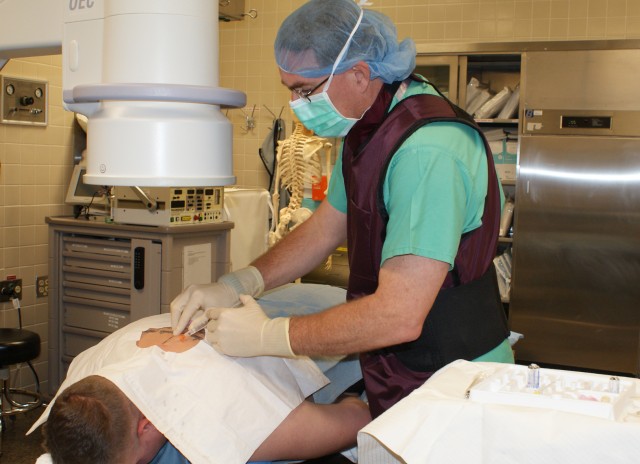FORT HOOD, Texas, Feb. 7, 2011 -- Injury and pain may be considered just a consequence of the job for many Soldiers, but the medical professionals at Carl R. Darnall Army Medical Center here are striving to help wounded Soldiers manage their pain so they can continue their Army careers.
"We've definitely seen a steady increase in the incidence of acute and chronic pain within the military population. Just in the nature of their jobs and what they do every day, Soldiers are at a greater risk for developing chronic pain," said Dr. Richard Erff, chief of the CRDAMC Pain Clinic. "Helping Soldiers manage their pain presents some challenges for us, but we have been successful in helping them experience appreciable relief."
The International Association for the Study of Pain defines chronic pain as pain that persists beyond the typical three-month healing time. Chronic pain can result from injury or surgery and is severe enough to disrupt normal functioning. Many acute or less severe pain issues transition into chronic conditions that require a comprehensive approach to treatment.
"Pain becomes a problem when it is so severe that it keeps you from functioning at your normal level," Erff said. "People experience pain in different ways, too. Some may have a constant pain or a pain that fluctuates-flaring on some days, waning on others. Some may be living with the same pain for years. Some may only experience pain when doing a specific activity."
Whatever type of pain they are experiencing, Erff said that there is relief available as there are many therapies and strategies that can help.
"Soldiers shouldn't take a 'tough it out' stance when dealing with their pain. It's important to see a medical provider," Erff stated. "And the sooner you see someone about your pain, the better it will be for you, since the longer pain persists, the harder it is to treat."
He added that pain management is individualized, depending on the type of pain and treatment is typically done in progressive stages.
"Depending on the nature of the pain, we usually will start treating with less invasive methods and then move to more complex options such as injection or surgery as necessary," he explained. "We have so many treatment options that we can use. We've made tremendous strides from the days of just prescribing pain medication."
While medications are still a part of the treatment for pain, there are many more ways to help people manage their pain. Erff said some of the conservative therapeutic options available include: chiropractic care, acupuncture, physical therapy, transcutaneous electrical nerve stimulation, transdermal patches, aerobic conditioning, meditation and biofeedback.
Some of the interventional medicine therapies available include: steroid injections, nerve blocks and ablations, epidural injections and spinal cord stimulation.
He encouraged everyone to take an active role in managing their pain. Treatment has to be comprehensive, involving a combination of conservative therapy and interventional medicine, plus possible lifestyle and behavioral health changes.
"Treatment methods for pain have improved tremendously. With the use of today's interventional medicine strategies, the Army is achieving about a 90-percent retention rate on the battlefield," Erff said. "At our clinic we've had a great success rate, with many personal success stories. While our goal is to achieve a minimal 50 percent improvement in functionality, we have exceeded that for many of our patients and are able to retain many more Soldiers."
Spc. Michael Ryan from the 1st Battalion, Warrior Transition Brigade, said he is pleased with the way the Darnall Pain Clinic has helped him manage his neck and back pain.
"I've been to other clinics, but this is by far the best. In just the few months I've been coming here, I've made major progress," he said.
Ryan has chronic pain from a traumatic brain injury he received while deployed to Iraq.
"Before, I couldn't walk 20 feet," Ryan explained. "Now I can walk for 20 minutes. Before, I couldn't clean my own house. Now I help with chores every day."
Erff anticipates the clinic will be able to help even more patients as it continues to grow and expand services in the future. The new hospital in 2014 will have a dedicated pain clinic with two interventional medicine suites.
"Chronic pain is a treatable and manageable disease," Erff said. "The pain clinic can help wounded and injured Soldiers manage their chronic pain, offering them improved function, qualify of life and the opportunity to continue their military service."
Related Links:
Army looking at yoga, acupuncture to treat pain
Army takes a hard look at chronic, acute pain
STAND-TO!: Pain Management Task Force


Social Sharing